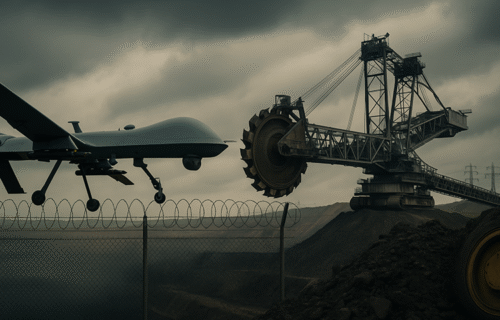Europe is racing to secure its future on two intertwined battlefields — one defined by missiles and drones, the other by minerals and supply chains. As tensions escalate along NATO’s eastern border and China tightens control over exports vital to modern warfare, the continent faces a blunt truth: it cannot defend itself if it cannot build the tools of defence.
Across European capitals, urgency is now the watchword. Finland’s defence minister, Antti Häkkänen, has become one of the most vocal advocates for rapid rearmament. Speaking at recent security forums, he warned that Europe is “in a race against time” to strengthen its air defences and build what has been dubbed the “drone wall” — a coordinated network of sensors, interceptors, and counter-drone technologies stretching from Finland to Poland. The initiative, backed by the European Commission, is designed to protect NATO’s eastern flank from the rising number of aerial incursions linked to Russia’s hybrid warfare strategy.
But while political determination is growing, practical readiness remains patchy. Member states disagree on how fast such a system can be built. Some, like Latvia, believe it could be operational within a year; others, such as Germany, caution that developing and integrating the technologies could take several more. The delay is not merely bureaucratic — it is structural. European armies depend on high-tech components and rare materials that are increasingly difficult to obtain.
That second front — the industrial one — is now emerging as just as critical as the military response itself. Beijing’s recent expansion of export restrictions on rare earth elements and other strategic resources has reignited alarm across Europe’s defence and aerospace sectors. These materials, from tungsten and magnesium to neodymium, are indispensable for radar systems, electric vehicles, guided missiles, and even jet turbines. The new rules, which prohibit exports tied to foreign militaries, could slow production lines and raise costs for Europe’s defence manufacturers, many of whom are already stretched by the demands of rearmament.
Industry associations representing companies like Airbus, BAE Systems, Saab, Thales and Rheinmetall have warned that Europe’s supply chains are fragile at precisely the moment they need to be most resilient. Larger corporations have the reserves and networks to adapt, but smaller firms — crucial to the continent’s munitions and drone supply base — could struggle to source critical inputs. Analysts say that without stable access to materials, Europe’s ambitious defence spending plans risk being delayed or derailed entirely.
In response, Brussels has accelerated efforts to rebuild the continent’s industrial backbone. The Critical Raw Materials Act, passed earlier this year, sets ambitious targets for 2030: at least 10% of the EU’s needs to be met through domestic mining, 40% through processing, and 25% through recycling. Several projects are already underway, including a major rare earth processing plant in France and a new magnet manufacturing facility in Estonia. Together, they mark Europe’s first serious attempt in decades to create a self-sufficient production chain for strategic materials.
Yet the process is slow and costly. Environmental and permitting challenges threaten to delay new mines and refineries for years, while the technical expertise needed to operate them has dwindled. The balancing act between strategic autonomy and green policy commitments has become a flashpoint in Brussels, where some argue that Europe’s security must temporarily take precedence over environmental constraints.
Meanwhile, defence leaders like Häkkänen insist that Europe can no longer afford hesitation. He argues that Russia interprets delay as weakness and will continue probing NATO’s defences until the alliance proves it can respond swiftly and decisively. His warning echoes through a Europe that is still grappling with energy dependence and economic fragility: the continent that once prided itself on soft power must now rediscover hard resilience.
The United States’ shifting focus toward the Indo-Pacific only heightens the urgency. Washington has signalled that Europe must shoulder more of its own defence burden, reinforcing the message that security begins at home. The NATO summit in The Hague earlier this year set a bold spending goal — up to 5% of GDP on defence and related sectors by 2035 — but the ability to spend that money effectively will depend on industrial capacity and access to materials.
For now, Europe’s two fronts — the military build-up and the industrial catch-up — are moving at different speeds. Political will is growing faster than manufacturing capability, and the gap between the two may determine how prepared the continent truly is when the next crisis comes.
What Europe faces is not only a geopolitical test but a supply chain reckoning. As one analyst put it, “You can’t defend your skies if you don’t control the mines.”
The next few years will show whether Europe can turn its promises of urgency into tangible defences — from the fields of eastern Poland to the furnaces of Estonia — before the window for action closes.
